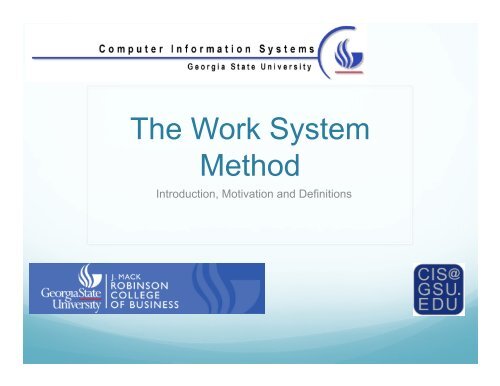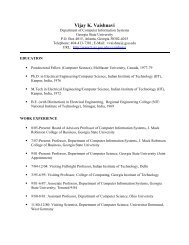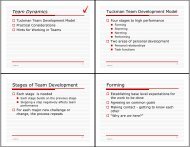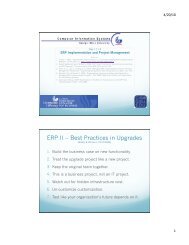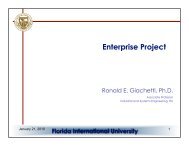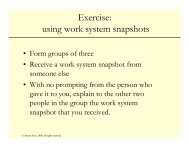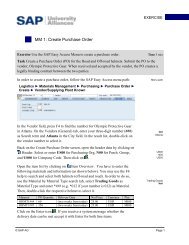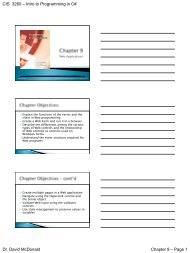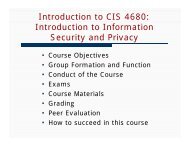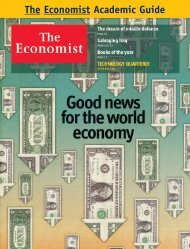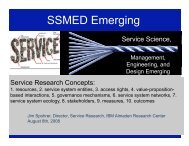The Work System Method - Department of Computer Information ...
The Work System Method - Department of Computer Information ...
The Work System Method - Department of Computer Information ...
Create successful ePaper yourself
Turn your PDF publications into a flip-book with our unique Google optimized e-Paper software.
<strong>The</strong> <strong>Work</strong> <strong>System</strong><br />
<strong>Method</strong><br />
Introduction, Motivation and Definitions
Definition<br />
• <strong>Work</strong><br />
• <strong>The</strong> application <strong>of</strong> resources such as<br />
people, equipment, time, effort, and<br />
money to generate products and<br />
services for internal or external<br />
customers
<strong>Work</strong> <strong>System</strong><br />
• <strong>Work</strong> <strong>System</strong> - a system in which human participants<br />
and/or machines perform work using information,<br />
technology, and other resources to produce products and/or<br />
services for internal or external customers.<br />
• Typical business organizations contain work systems that procure<br />
materials from suppliers, produce products, deliver products to<br />
customers, find customers, create financial reports, hire employees,<br />
coordinate work across departments, and perform many other<br />
functions.<br />
• Every work system can be viewed as a subsystem <strong>of</strong> a larger work<br />
system, the boundaries <strong>of</strong> a work system are treated as a carefully<br />
considered decision by the work system modeler.<br />
• In general, the relevant work system for a particular analysis is the<br />
smallest work system that exhibits or possesses the problem, issue,<br />
or opportunity that prompted the analysis
<strong>Work</strong> <strong>System</strong>s<br />
• Typical business organizations contain work systems that<br />
procure materials from suppliers, produce products, deliver<br />
products to customers, find customers, create financial<br />
reports, hire employees, coordinate work across<br />
departments, and perform many other functions.<br />
• Every work system can be viewed as a subsystem <strong>of</strong> a<br />
larger work system, the boundaries <strong>of</strong> a work system are<br />
treated as a carefully considered decision by the work<br />
system modeler.<br />
• In general, the relevant work system for a particular<br />
analysis is the smallest work system that exhibits or<br />
possesses the problem, issue, or opportunity that prompted<br />
the analysis
Examples <strong>of</strong> <strong>Work</strong> <strong>System</strong>s<br />
(from papers by MBA students at Georgia State Univ. )<br />
Calculating rates for<br />
insurance renewals<br />
Managing s<strong>of</strong>tware<br />
development projects<br />
Acquiring clients at a<br />
pr<strong>of</strong>essional service firm<br />
Receiving materials at a<br />
large warehouse<br />
Approving real estate loan<br />
applications<br />
Planning and dispatching<br />
trucking services<br />
Performing preemployment<br />
background<br />
checks<br />
Performing financial<br />
planning for wealthy<br />
individuals<br />
Scheduling and tracking<br />
health service<br />
appointments<br />
Operating an engineering<br />
call center<br />
Purchasing advertising<br />
services<br />
Determining salary<br />
increases<br />
Collecting and reporting<br />
sales data for a<br />
wholesaler<br />
© Steven Alter, 2009, all rights reserved<br />
Planning for outages in<br />
key real time information<br />
systems<br />
Invoicing for construction<br />
work
Example work <strong>System</strong>s<br />
<strong>Work</strong> system #1: How a bank approves commercial loans.<br />
<strong>Work</strong> system #2: How a s<strong>of</strong>tware vendor tries to find and qualify sales<br />
prospects.<br />
<strong>Work</strong> system #3: How Zoo Atlanta defines its membership recruitment<br />
process.<br />
<strong>Work</strong> system #4: How A major bank authenticates callers to be bona fide<br />
customers before connecting to a call center.<br />
6
A Limiting Paradigm…<br />
Viewing <strong>System</strong>s as IT-based tools that are used by<br />
users.<br />
© Steven Alter, 2010
<strong>Work</strong> systems are NOT <strong>Information</strong> <strong>System</strong>s<br />
<strong>Information</strong> <strong>System</strong>s<br />
<strong>Work</strong> systems supported by information<br />
systems<br />
8
© Steven Alter, 2010<br />
<strong>Work</strong> <strong>System</strong> Framework
One Lens Fits Almost All<br />
<strong>Work</strong> system<br />
Service system<br />
<strong>Information</strong> system<br />
Project<br />
Supply chain<br />
Use <strong>of</strong> e-commerce web site<br />
(c) Steven Alter 2012
Basics <strong>of</strong> <strong>Work</strong> <strong>System</strong><br />
<strong>Method</strong><br />
<strong>System</strong> and Problem<br />
Define work system based on problem<br />
Summarize “as is” using work system snapshot<br />
Analysis and Possibilities<br />
Drill down using work system elements and alignment within<br />
the work system<br />
Recommendation and Justification<br />
Summarize “to be” using work system snapshot<br />
Drill down to understand impact <strong>of</strong> changes<br />
10 questions related to recommendation and justification<br />
© Steven Alter, 2010
A Starting point:<br />
<strong>The</strong> <strong>Work</strong> <strong>System</strong> Snapshot<br />
• a highly summarized but balanced view <strong>of</strong> a work system that a business<br />
pr<strong>of</strong>essional can produce quickly or can understand quickly when it is<br />
presented.<br />
• uses six central elements to summarize what a system is and what it produces.<br />
At this summary level distinctions between technology and technical<br />
infrastructure are unimportant.<br />
12
<strong>Work</strong> system snapshot<br />
example<br />
(c) Steven Alter 2012
Customers<br />
Loan applicant<br />
Bank’s Risk Management <strong>Department</strong> and top management (a<br />
secondary customer)<br />
Federal Deposit Insurance Corporation (FDIC) (a secondary<br />
customer)<br />
Products & Services<br />
Loan application<br />
Loan write-up<br />
Approval or denial <strong>of</strong> the loan application<br />
Explanation <strong>of</strong> the decision<br />
Loan documents<br />
Major Processes and Activities<br />
Loan <strong>of</strong>ficer and loan applicant discuss the client’s financing needs and discuss possible terms <strong>of</strong> the proposed loan.<br />
Loan <strong>of</strong>ficer helps loan applicant compile a loan application including financial history and projections.<br />
Loan <strong>of</strong>ficer and senior credit <strong>of</strong>ficer meet to verify that the loan application has no glaring flaws.<br />
Credit analyst prepares a “loan write-up” summarizing the applicant’s financial history, providing projections explaining sources <strong>of</strong><br />
funds for loan payments, and discussing market conditions and applicant’s reputation. Real estate loans all require an appraisal<br />
by a real estate appraiser.<br />
Loan <strong>of</strong>ficer presents the loan write-up to a senior credit <strong>of</strong>ficer or loan committee.<br />
Senior credit <strong>of</strong>ficers approve or deny loans <strong>of</strong> less than $400,000; a loan committee or executive loan committee approves<br />
larger loans.<br />
Loan <strong>of</strong>ficers may appeal a loan denial or an approval with extremely stringent loan covenants. Depending on the size <strong>of</strong> the loan,<br />
the appeal may go to a committee <strong>of</strong> senior credit <strong>of</strong>ficers, or to a loan committee other than the one that made the original<br />
decision.<br />
Loan <strong>of</strong>ficer informs loan applicant <strong>of</strong> the decision.<br />
Loan administration clerk produces loan documents for an approved loan that the client accepts.<br />
Participants <strong>Information</strong> Technologies<br />
Loan <strong>of</strong>ficer<br />
Loan applicant<br />
Credit analyst<br />
Senior credit <strong>of</strong>ficer<br />
Loan committee and executive<br />
loan committee<br />
Loan administration clerk<br />
Real estate appraiser<br />
Applicant’s financial statements for last three years<br />
Applicant’s financial and market projections<br />
Loan application<br />
Loan write-up<br />
Explanation <strong>of</strong> decision<br />
Loan documents<br />
Spreadsheet for consolidating<br />
information<br />
Loan evaluation model<br />
MS Word template<br />
Internet<br />
Telephones
Explain why the following is or is not a<br />
good work system snapshot<br />
Applicant<br />
Customers<br />
Loan<br />
Products & Services<br />
Major Processes and Activities<br />
* Find applicants<br />
* Produce loan application<br />
* Approve or decline<br />
* Send paperwork<br />
Participants <strong>Information</strong> Technologies<br />
* Applicant<br />
* Loan <strong>of</strong>fice<br />
*Committee<br />
* Application<br />
*<br />
*<br />
* Telephone<br />
* Spreadsheet<br />
* Word processor<br />
(c) Steven Alter 2012
Characteristics <strong>of</strong> a good work<br />
system snapshot?<br />
Describes the relevant work system<br />
<strong>The</strong> smallest work system that has the problem or<br />
opportunity that is being analyzed<br />
<strong>The</strong> boundaries <strong>of</strong> a work system are not known in<br />
advance.<br />
No more than one page<br />
Internal consistency: See Guidelines following<br />
(c) Steven Alter 2012
Customers<br />
<strong>The</strong> people who receive, use, or benefit directly from<br />
products and services that a work system produces.<br />
In most cases they can experience or perceive the quality <strong>of</strong> those<br />
products and services.<br />
Customers include external customers and internal customers.<br />
External customers receive and use the economic products<br />
and/or services that a firm produces. Firms exist to produce<br />
those products and services.<br />
Internal customers are employees or contractors who receive<br />
and use a work system’s products and/or services while<br />
performing work in other parts <strong>of</strong> the same firm’s value chain.
Products and Services<br />
• the combination <strong>of</strong> physical things, information,<br />
and services that the work system produces for its<br />
various customers.<br />
• products and services may take various forms,<br />
including physical products, information<br />
products, services, intangibles such as<br />
enjoyment and peace <strong>of</strong> mind, and social<br />
products such as arrangements and<br />
agreements.
Intermediate Products and<br />
Services<br />
intermediate products and services --used by other activities<br />
within the work system.<br />
not considered to the products and services <strong>of</strong> the work<br />
system unless they are received and used by the customers <strong>of</strong><br />
the work system for some purpose outside <strong>of</strong> the work system.<br />
E.g., assume that a loan approval process produces a formal<br />
evaluation <strong>of</strong> a loan.<br />
<strong>The</strong> approval is considered to be among the products and<br />
services <strong>of</strong> the work system if it goes to a work system<br />
customer for some purpose outside <strong>of</strong> the work system.<br />
If the approval process is only used to make a decision in<br />
a subsequent activity and then discarded; it is an<br />
intermediate process.
Participants<br />
People who perform the work<br />
<strong>The</strong> role <strong>of</strong> work system participant is more important than the<br />
more limited role <strong>of</strong> technology user, whether or not particular<br />
participants happen to be technology users.<br />
Customers are participants in many work systems.<br />
Minimal involvement-- such as when their request launches a<br />
production process that they are not involved in.<br />
Vs quite involved (e.g., selecting furnishings for a room with<br />
the help <strong>of</strong> a designer or sales person, learning in a classroom<br />
with the help <strong>of</strong> a teach, and helping a doctor perform a<br />
medical examination).<br />
A strong trend -- toward self-service work systems whose<br />
customers perform much <strong>of</strong> the important work (e.g., paying bills<br />
online, using an ATM, or doing research on the internet about a<br />
possible car purchase).
<strong>Information</strong><br />
Includes codified and non-codified information used and<br />
created as participants perform their work.<br />
Codified information is the pre-defined information used in<br />
tracking packages, entering orders, and performing repetitive<br />
financial transactions.<br />
In each case, each data item must be defined precisely, and<br />
the information is usually processed using explicit rules.<br />
Uncodified information includes computerized or handwritten<br />
documents, verbal agreements, and formal or informal<br />
conversations. <strong>Information</strong> may or may not be computerized.<br />
Knowledge can be viewed as a special case <strong>of</strong> information.<br />
Explicit knowledge is recorded in documents, images, rules,<br />
and other forms.<br />
Tacit knowledge exists in people’s heads and is not explicit.
Technologies<br />
Tools that help people work more efficiently or that<br />
perform automated work steps autonomously.<br />
Some technologies, such as search engines, cell<br />
phones, spreadsheet s<strong>of</strong>tware, and automobiles, are<br />
general-purpose because they can be applied in a<br />
wide range <strong>of</strong> business situations.<br />
Other technologies are tailored to specific<br />
situations.<br />
Examples include a spreadsheet model for<br />
calculating mortgage interest and a s<strong>of</strong>tware<br />
package for designing kitchens.
Infrastructure<br />
Human, informational, and technical resources<br />
that the work system relies on but are outside the<br />
work system and are shared resources with other<br />
work systems.<br />
Human infrastructure -people and organizations that supply services<br />
shared by different work systems.<br />
For example, training organizations, internal consultants, and human<br />
resources departments are typically considered part <strong>of</strong> the human<br />
infrastructure that may be relevant to a work system.<br />
<strong>Information</strong> infrastructure -- information shared across various work<br />
systems, such as mutually accessible databases and other enterprise-wide<br />
information.<br />
Technical infrastructure includes the Internet, corporate computer<br />
networks, database management s<strong>of</strong>tware, and other technologies shared<br />
by multiple work systems and <strong>of</strong>ten hidden or invisible to work system<br />
participants.<br />
e.g., Enterprise s<strong>of</strong>tware such as ERP suites is technical<br />
infrastructure that is shared across multiple work systems. A specific<br />
program or module in an ERP suite can be viewed as technology
Environment<br />
<strong>The</strong> organizational, cultural, competitive,<br />
technical, and regulatory environment within which<br />
the work system operates.<br />
Factors in the environment affect work system<br />
performance even though the work system does not rely<br />
on them directly in order to operate.<br />
<strong>The</strong> organization’s general norms <strong>of</strong> behavior are part<br />
<strong>of</strong> the culture in the environment that surrounds the<br />
work system, whereas…<br />
Behavioral norms and expectations about specific<br />
activities within the work system are considered<br />
characteristics <strong>of</strong> processes and and activities within the<br />
work system.
Strategies<br />
<strong>The</strong> guiding rationale and high-level choices<br />
within which a work system, organization, or firm is<br />
designed and operates.<br />
Strategies at the department and enterprise level may<br />
help in explaining why the work system operates as it<br />
does and whether it is operating properly.<br />
A work system’s strategy (its guiding rationale and<br />
high-level choices) should be aligned with the strategy<br />
<strong>of</strong> the organization and firm that it serves.<br />
E.g., a work system designed to produce the<br />
highest quality products might not fit in an<br />
organization operating under a cost minimization<br />
strategy.
Internal consistency guidelines<br />
for a work system snapshot<br />
Processes and activities are complete sentences that<br />
identify actions and who performs the actions.<br />
Participants perform at least one step<br />
Customers receive and use products and services.<br />
Any information mentioned is used or produced in at least<br />
one process or activity<br />
Any technology mentioned is used or produced in at least<br />
one process or activity.<br />
Every customer group that is mentioned receives or uses at<br />
least one <strong>of</strong> the products and services<br />
(c) Steven Alter 2012
Typical problems in work system<br />
snapshots<br />
Describing the whole company, not just one work<br />
system<br />
Viewing programmers as participants in a system<br />
that uses IT<br />
Viewing department managers as participants in<br />
operational systems that they only supervise<br />
Treating technology as the product <strong>of</strong> the system<br />
Ignoring ways in which customers are participants<br />
(c) Steven Alter 2012
Analysis <strong>of</strong> <strong>System</strong>s<br />
Describe<br />
Identify Criteria<br />
Evaluate in Relation to Criteria<br />
Draw conclusions or make recommendation<br />
(c) Steven Alter 2012
Metrics<br />
Metrics are measures <strong>of</strong> performance during a time period,<br />
not built-in characteristics.<br />
Metrics are related to management issues, such as speed,<br />
accuracy, rate <strong>of</strong> output, cost, reliability, and conformance.<br />
A metric includes a unit <strong>of</strong> measure such as:<br />
Units per hour<br />
Defects per 1000<br />
Minutes from start to finish<br />
Percentage <strong>of</strong> rework during a week<br />
Downtime percentage<br />
Cost to the customer<br />
Cost <strong>of</strong> production per unit
Metrics<br />
• <strong>The</strong> value <strong>of</strong> a metric is a number describing how well a<br />
work system or part <strong>of</strong> a work system is currently operating<br />
or operated in the past. Here are some examples:
Aspect <strong>of</strong><br />
performance<br />
(c) Steven Alter 2012<br />
Metrics and Performance Gaps<br />
Metric (specific<br />
measure <strong>of</strong><br />
performance in this<br />
situation)<br />
Current value <strong>of</strong><br />
metric<br />
Realistic desired<br />
value <strong>of</strong> metric<br />
Amount <strong>of</strong> production Total output per week 50 units per week 60 units per week<br />
Speed<br />
Cost<br />
Inefficiency due to<br />
rework<br />
Errors<br />
Customer satisfaction<br />
Average time to<br />
resolve customer<br />
questions<br />
Cost per invoice<br />
handled<br />
4 hours 2.5 hours<br />
$5.35 $2.00<br />
Rework rate 10% 3%<br />
Error rate in<br />
calculations<br />
Customer satisfaction<br />
ratings from a survey<br />
3% 0.5%<br />
6.2 out <strong>of</strong> 7.0 on a<br />
monthly survey<br />
Equipment utilization Uptime <strong>of</strong> equipment 99.5 % 99.8%<br />
6.7 out <strong>of</strong> 7.0 on a<br />
monthly survey
Metric examples
Level <strong>of</strong> Abstraction & Analysis<br />
• Organizational Analysis levels (include )<br />
… the entire enterprise,<br />
… a department within an enterprise,<br />
….a work system within a department within an enterprise,<br />
… a subsystem <strong>of</strong> the work system.<br />
<strong>The</strong> person doing the analysis should decide on the right organizational level<br />
for the analysis that needs to be done.<br />
• <strong>The</strong> level <strong>of</strong> detail differs across the roles and across<br />
different situations.<br />
• In all cases, the analysis and design <strong>of</strong> a system<br />
should include typical steps <strong>of</strong> identifying the problem<br />
and system, performing an analysis, and producing a<br />
justified recommendation.<br />
• People in different roles should use the framework and<br />
related ideas at different levels <strong>of</strong> depth.
Premises <strong>of</strong> the <strong>Work</strong> <strong>System</strong> <strong>Method</strong><br />
<strong>The</strong> goal: Improving business performance.<br />
Assumption: Business performance is generated<br />
by operation <strong>of</strong> sociotechnical work systems.<br />
Improvement process: Changing work systems,<br />
not just creating, installing, or using information<br />
systems or IT.<br />
Links to more formal ISA&D techniques (UML,<br />
SOA, etc.)<br />
Decompose work systems into smaller work systems:<br />
some <strong>of</strong> which are sociotechnical<br />
some <strong>of</strong> which are autonomous computerized agents.<br />
© Steven Alter, 2010
Q: Should Business Pr<strong>of</strong>essionals<br />
Analyze <strong>System</strong>s for <strong>The</strong>mselves?<br />
Can they be trusted?<br />
Do they have the appropriate skill and knowledge?<br />
IF NOT: How is it possible for them to do their work and<br />
manage organizations?<br />
IF NOT: How is it possible for them to participate in the<br />
development <strong>of</strong> information systems?<br />
What system should be analyzed?<br />
© Steven Alter, 2010
Typical <strong>System</strong>s Analysis<br />
<strong>Method</strong>s are created for IT<br />
Pr<strong>of</strong>essionals<br />
Mostly about documentation, not really about analysis<br />
Emphasis on precision and completeness<br />
Complex, opaque terminology<br />
Emphasis on use <strong>of</strong> tools, not on business performance<br />
© Steven Alter, 2010
<strong>Work</strong> <strong>System</strong> <strong>Method</strong>:<br />
a kind <strong>of</strong> <strong>System</strong>s Analysis for Everyone<br />
Else<br />
Aha! Business pr<strong>of</strong>essionals need to focus on work<br />
systems, not just IS or IT.<br />
© Steven Alter, 2010
Positioning <strong>of</strong> <strong>Work</strong> <strong>System</strong><br />
Approach<br />
Enterprise<br />
level<br />
Organizational<br />
architecture<br />
Technical<br />
infrastructure<br />
IT-reliant work<br />
systems in<br />
organizations<br />
Local<br />
level<br />
Localized rules<br />
and routines<br />
Tools, algorithms,<br />
computer programs<br />
Predominance <strong>of</strong> design<br />
and social science<br />
Predominance <strong>of</strong> engineering<br />
and computer science<br />
Links that ignore IT-reliant work systems within organizations<br />
Links that emphasize IT-reliant work systems within organizations<br />
© Steven Alter, 2010
Chapter 1<br />
<strong>System</strong>s a mess: Seven Common Temptations<br />
• Temptation #1: Viewing technology as the system.<br />
• Temptation #2: Assuming technology is a magic bullet.<br />
• Temptation #3: Abdicating responsibility for systems.<br />
• Temptation #4: Avoiding performance measurement<br />
• Temptation #5: Accepting superficial analysis.<br />
• Temptation #6: Accepting one-dimensional thinking.<br />
• Temptation #7: Assuming desired changes will<br />
implement themselves
“From a business viewpoint, the work defines<br />
the system, not the technology that is used to<br />
do the work.”<br />
An organization as a group <strong>of</strong> work systems.<br />
It is possible to view an entire organization as a<br />
single work system.<br />
In most situations, however, is better to view an<br />
organization as a combination <strong>of</strong> many smaller<br />
work systems.<br />
Viewing an entire firm as a single work system<br />
tends to produce a bloated analysis that covers<br />
too many groups <strong>of</strong> people performing too many<br />
different types <strong>of</strong> roles and activities.
Different types <strong>of</strong> overlap between work<br />
systems and IS
Scoping the <strong>Work</strong> <strong>System</strong><br />
…the work system being analyzed should be defined as the<br />
smallest work system that has the problems or opportunities that<br />
launched the analysis.<br />
<strong>The</strong> work system’s outputs are the products and services it<br />
produces for its customers.<br />
<br />
Those customers are <strong>of</strong>ten participants in other work systems that use the<br />
products and services.<br />
<strong>The</strong> work system’s inputs are information and other resources it<br />
receives from other work systems and from other sources.<br />
<br />
<br />
<br />
Some <strong>of</strong> the inputs a work system receives are not important enough to list on a<br />
one-page summary.<br />
Those that are important enough to include should be mentioned explicitly in the<br />
activities listed under work practices.<br />
For example, a sales system might start with a prospect list produced by a<br />
different work system. In that case, the first activity listed under work practices<br />
would be something like “salesperson contacts prospect on prospect list.”
Consistency guidelines…
Step 2:<br />
Change<br />
what?
Metrics?<br />
Derived form an improvement attribute<br />
Accuracy 10 ways to measure accuracy<br />
Speed how do you measure speed?
<strong>Work</strong> <strong>System</strong> Analysis<br />
Feed (forward & back),<br />
common misconceptions,<br />
errors, pitfalls and<br />
challenges you will likely<br />
face
Use the template tool<br />
Name the snapshot<br />
Complete the cover and required forms last<br />
Identify the industry and problem time<br />
Complete the informed consent form<br />
Complete the WHOLE template<br />
Pr<strong>of</strong>essor<br />
Truex
<strong>Work</strong> system analysis assumptions<br />
You are doing a preliminary analysis.<br />
Remember that your recommendation will go to a management committee that<br />
will decide whether to start a project to implement your recommendations.<br />
Include a bit <strong>of</strong> the background:<br />
Don’t assume that everyone knows the environment and background and<br />
acronyms<br />
Select and pertinent aspects <strong>of</strong> the situation needed to understand the analysis<br />
Your analysis must:<br />
Start with a clear problem definition followed by problem-related facts,<br />
conclusions, and logic.<br />
Your recommendations should:<br />
Your view <strong>of</strong> what actions should be taken to address the problem.<br />
Be specific because the reader sees little value in vague recommendations.<br />
Refer to measures and a base-line comparison<br />
Be measurable and if possible quantitative, e.g. provide a 30% reduction in hold<br />
times
Common pitfalls<br />
Is the <strong>Work</strong> <strong>System</strong> identified-and named?<br />
Is the topic really a <strong>Work</strong> <strong>System</strong>?<br />
Important: Recall that an ERP or any other IS by itself is NOT a work system, but may<br />
be part <strong>of</strong> a WS, or an instance <strong>of</strong> part <strong>of</strong> a WS<br />
Is this work system worth analyzing?<br />
Is there a chance for innovation?<br />
Do the recommendations make sense?<br />
Is the analysis and paper convincing?<br />
Is the paper readable<br />
or is it repetitious, inconsistent, etc.<br />
Does it read like a draft (because no one pro<strong>of</strong> read it?)
Probable challenges you faced in the<br />
assignment…<br />
Scoping, choosing the boundary<br />
Choosing the right level <strong>of</strong> abstraction<br />
How high, how deep or how ‘close to the bottom’ do I go?<br />
Naming<br />
“So in naming meaning begins” (poet M. vanTilberg, 1972)<br />
Not getting ahead <strong>of</strong> yourself<br />
Do not jump to the solution before examining the problem<br />
Course name<br />
Pr<strong>of</strong>essor<br />
Truex
Four key parts <strong>of</strong><br />
<strong>The</strong> Executive Summary<br />
1. Brief Context <strong>of</strong> the WS’s environment<br />
2. Description <strong>of</strong> the <strong>Work</strong> <strong>System</strong><br />
WS Name is/does the following<br />
<br />
Here are key parameters <strong>of</strong> performance<br />
3. Description <strong>of</strong> the issues with the as-is WK<br />
<br />
This is why those problems matter<br />
Here are metrics needing a fix<br />
E.g., “<strong>The</strong> systems has these problems/issues…”<br />
4. Describe alternatives and the proposed ‘fix’<br />
We propose to do x, …y,… and z…<br />
<br />
What are the measures and the metrics?<br />
This is the estimated gain in doing these things…<br />
Course name<br />
Pr<strong>of</strong>essor<br />
Truex
Grammar Matters<br />
Algorithm for improved writing:<br />
Think, and plan a structure <strong>of</strong> the ideas/analysis<br />
Loop::<br />
Write a draft<br />
Read the draft critically,<br />
edit, revise, & improve<br />
Repeat… until done<br />
Read your text aloud, ask another to pro<strong>of</strong>read when possible.<br />
switch on MS Word’s grammar and spelling tool<br />
Course name<br />
Pr<strong>of</strong>essor<br />
Truex
Extensions to the basic <strong>Work</strong><br />
systems modeling concept.
<strong>Work</strong> <strong>System</strong> Life Cycle<br />
Model<br />
Operation &<br />
Maintenance<br />
Initiation<br />
Implementation<br />
Development
<strong>Work</strong> <strong>System</strong> Life Cycle Model<br />
(continued)<br />
Planned and unplanned change<br />
Planned change is achieved through formal projects<br />
Unplanned change occurs through adaptations,<br />
workarounds, experimentation<br />
Relevant to work systems in general, not just IT<br />
projects.<br />
Relevant to recommendations for improving any work<br />
system<br />
Recommendations must be implemented.
Terminology for Talking about<br />
<strong>Work</strong> <strong>System</strong> Life Cycles<br />
Iterations<br />
From one version <strong>of</strong> a work system to the next<br />
version <strong>of</strong> the work system<br />
Phases<br />
Operation and maintenance<br />
Initiation<br />
Development<br />
Implementation
Terminology for Talking about <strong>Work</strong><br />
<strong>System</strong> Life Cycles (continued)<br />
Rework<br />
Re-doing work within a phase<br />
Returning to a previous phase to resolve difficulties in<br />
the current phase<br />
Adaptation and experimentation<br />
Small changes within a phase; not a separate project<br />
involving allocation <strong>of</strong> significant resources<br />
Continuous vs. discontinuous change<br />
Continuous: small adaptations, experimentation<br />
Discontinuous: formal projects directed as significant<br />
changes
Clarifications <strong>of</strong> the Life Cycle<br />
Model<br />
Initially, “as-is” work<br />
system;<br />
Later, “to-be” work system<br />
Operation &<br />
Maintenance<br />
Implementation<br />
Ongoing adaptations,<br />
experimentation, etc.<br />
Initiation<br />
Development<br />
A small work<br />
system in its own<br />
right; <strong>of</strong>ten a cause<br />
<strong>of</strong> failure<br />
Need to revisit<br />
initiation is<br />
<strong>of</strong>ten ignored<br />
Refers to the<br />
work system,<br />
not just the IS<br />
Possibilities for<br />
adaptations and<br />
discoveries<br />
May or may not<br />
involve s<strong>of</strong>tware<br />
development
Assumptions built into the<br />
work system life cycle model<br />
<strong>System</strong>s evolve through iterations<br />
WSLC includes planned and unplanned change<br />
Adaptation and experimentation are positive,<br />
not negative<br />
“<strong>System</strong> development life cycle” (SDLC ) <strong>of</strong>ten<br />
mentioned by IT pr<strong>of</strong>essionals is basically a<br />
project from initiation to implementation
Operation and Maintenance<br />
Operate and monitor work system<br />
Continuous improvement <strong>of</strong> work practices<br />
through analysis, experimentation, and<br />
adaptation<br />
<strong>Information</strong> system maintenance including<br />
bug fixes and minor improvements
Initiation<br />
Clarify the reasons for changing the work<br />
system<br />
Identify the people and processes that will be<br />
affected<br />
Describe in general terms what the changes<br />
will entail<br />
Allocate the time and other resources<br />
necessary to accomplish the change<br />
Feasibility study<br />
May produce functional specification
Results <strong>of</strong> Initiation Phase<br />
Vision for the new work system<br />
Operational goals<br />
Allocation <strong>of</strong> resources and clarification <strong>of</strong><br />
time frames<br />
Evaluation <strong>of</strong> economic, organizational, and<br />
technical feasibility
Development<br />
• Process <strong>of</strong> specifying and creating or<br />
obtaining the tools, documentation,<br />
procedures, facilities, and other physical<br />
and informational resources needed before<br />
the desired changes can be implemented in<br />
the organization.<br />
Even if s<strong>of</strong>tware development is involved, business<br />
pr<strong>of</strong>essionals still have responsibilities.
Results <strong>of</strong> Development Phase<br />
Detailed requirements for the new work system,<br />
including information system requirements<br />
S<strong>of</strong>tware production, modification, or acquisition and<br />
configuration<br />
Hardware installation<br />
Acquisition and installation <strong>of</strong> other required<br />
resources<br />
Documentation and training materials<br />
Debugging and testing <strong>of</strong> hardware, s<strong>of</strong>tware, and<br />
documentation
Implementation<br />
Process <strong>of</strong> making the desired changes<br />
operational in the organization.<br />
Implementation activities include:<br />
planning the rollout<br />
training work system participants<br />
converting to the new work methods<br />
following-up to ensure the entire work system<br />
operates as it should
Implementation (continued)<br />
Implementation approach and plan (pilot?<br />
phased? big bang?)<br />
Change management efforts about rationale<br />
and positive/negative impacts <strong>of</strong> changes<br />
Training on details <strong>of</strong> the new work system,<br />
including information system usage<br />
Conversion to the new information system and<br />
new work system<br />
Acceptance testing
Conversion to the new work<br />
system<br />
Not just attaining usage <strong>of</strong> new s<strong>of</strong>tware<br />
Occurs after work system participants are<br />
trained<br />
To reduce risk, may require double work in<br />
transaction processing systems
Typical Issues within Each Phase<br />
Initiation<br />
Development<br />
* Can we agree on the purposes and goals <strong>of</strong><br />
the proposed changes?<br />
* Are the proposed changes feasible<br />
economically, technically, and organizationally?<br />
* Are the changes unnecessarily elaborate<br />
and expensive?<br />
* Can we assure that the work system<br />
changes genuinely solve the problem?<br />
* Do the information system changes conform<br />
to the organization’s expectations and<br />
standards for technical quality?
Typical Issues (continued)<br />
Implementation<br />
Operation and<br />
Maintenance<br />
* Can we convert effectively and painlessly<br />
from the old work system to the new work<br />
system?<br />
* Can we resolve personal and political issues<br />
related to changes in work patterns and power<br />
relationships?<br />
* Can we attain acceptable work system<br />
performance?<br />
* Can we maintain and improve performance<br />
with incremental changes, adjustments, and<br />
experimentation?
Four Types <strong>of</strong> Development Models for<br />
<strong>Information</strong> <strong>System</strong>s<br />
(most overlap with the development phase within the<br />
WSLC)<br />
Waterfall s<strong>of</strong>tware development<br />
Create a specification and built to it<br />
Prototyping/ agile<br />
Build and test multiple versions<br />
Commercial application package<br />
Buy s<strong>of</strong>tware instead <strong>of</strong> building it<br />
End – user development


